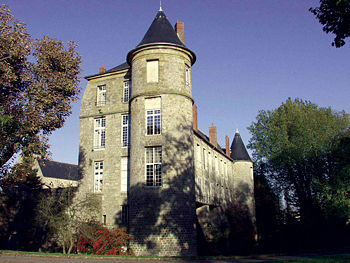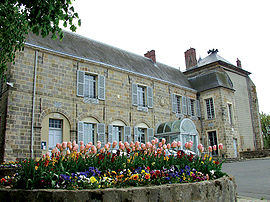
Château de Nangis
Encyclopedia

Castle
A castle is a type of fortified structure built in Europe and the Middle East during the Middle Ages by European nobility. Scholars debate the scope of the word castle, but usually consider it to be the private fortified residence of a lord or noble...
located in the heart of the town of Nangis
Nangis
Nangis is a commune in the Seine-et-Marne department in the Île-de-France region in north-central France.-External links:* * *...
, in the Seine-et-Marne
Seine-et-Marne
Seine-et-Marne is a French department, named after the Seine and Marne rivers, and located in the Île-de-France region.- History:Seine-et-Marne is one of the original 83 departments, created on March 4, 1790 during the French Revolution in application of the law of December 22, 1789...
département of France
France
The French Republic , The French Republic , The French Republic , (commonly known as France , is a unitary semi-presidential republic in Western Europe with several overseas territories and islands located on other continents and in the Indian, Pacific, and Atlantic oceans. Metropolitan France...
. It protected the population of the "seigneurie" (lord's domain
Manorialism
Manorialism, an essential element of feudal society, was the organizing principle of rural economy that originated in the villa system of the Late Roman Empire, was widely practiced in medieval western and parts of central Europe, and was slowly replaced by the advent of a money-based market...
) during the Hundred Years' War
Hundred Years' War
The Hundred Years' War was a series of separate wars waged from 1337 to 1453 by the House of Valois and the House of Plantagenet, also known as the House of Anjou, for the French throne, which had become vacant upon the extinction of the senior Capetian line of French kings...
. Today, it houses the town hall.
History
The name "La Motte" suggests the motte-and-baileyMotte-and-bailey
A motte-and-bailey is a form of castle, with a wooden or stone keep situated on a raised earthwork called a motte, accompanied by an enclosed courtyard, or bailey, surrounded by a protective ditch and palisade...
that indicates the middle-age origin of the place. Fleury (c. 1093-† c. 1147), son of the king Philip I of France
Philip I of France
Philip I , called the Amorous, was King of France from 1060 to his death. His reign, like that of most of the early Direct Capetians, was extraordinarily long for the time...
, is its oldest known lord ("seigneur"). In 1245, the castle came into the ownership of the Montmorency family. A well known fortress in 1397, the English inflicted important damage to the castle in 1429. The king Charles VII the Well-Served
Charles VII of France
Charles VII , called the Victorious or the Well-Served , was King of France from 1422 to his death, though he was initially opposed by Henry VI of England, whose Regent, the Duke of Bedford, ruled much of France including the capital, Paris...
gave the domain to Denis de Chailly from Chailly-en-Bière
Chailly-en-Bière
Chailly-en-Bière is a commune in the Seine-et-Marne department in the Île-de-France region in north-central France.-External links:* * *...
as a reward for his help to Jeanne d'Arc. He rebuilt the fortress in 1436.
By marrying Marie de Vères in 1507, Louis de Brichanteau became the new lord; his descendants kept the domain until the French Revolution
French Revolution
The French Revolution , sometimes distinguished as the 'Great French Revolution' , was a period of radical social and political upheaval in France and Europe. The absolute monarchy that had ruled France for centuries collapsed in three years...
. Around 1590, Antoine de Brichanteau modernised the residential building. The domain became a marquisate in 1612. The castle was visited by Louis XIV
Louis XIV of France
Louis XIV , known as Louis the Great or the Sun King , was a Bourbon monarch who ruled as King of France and Navarre. His reign, from 1643 to his death in 1715, began at the age of four and lasted seventy-two years, three months, and eighteen days...
in 1678. When Armand de Brichanteau died in 1742, a distant cousin, the count of Guerchy, became the new marquis. His son, Anne-Louis of Guerchy, the last marquis of Nangis, almost ruined, sold the castle to a Paris notary in 1795, who destroyed two of the three buildings, keeping only the left wing.
The castle was purchased by the city in 1859 and became the town hall. Viewed from the outside, the left wing has not changed much since then. Six paintings in the marriage room are portraits that were classified as historical monuments in May 1909 despite the fact that the building itself is not.
Description
Today, one can still see the moats of the old motte that were then filled with water. In those days, Jeanne d'Arc had crossed the drawbridgeDrawbridge
A drawbridge is a type of movable bridge typically associated with the entrance of a castle surrounded by a moat. The term is often used to describe all different types of movable bridges, like bascule bridges and lift bridges.-Castle drawbridges:...
to reach the keep
Keep
A keep is a type of fortified tower built within castles during the Middle Ages by European nobility. Scholars have debated the scope of the word keep, but usually consider it to refer to large towers in castles that were fortified residences, used as a refuge of last resort should the rest of the...
. The left wing that remains today has two corner towers. One can also see a cylindrical outer wall tower including loopholes. The "Mémoire" picture base of the Ministère de la Culture comprises two photos taken around 1907-1909, one showing the front view and the other, an outer wall tower.


